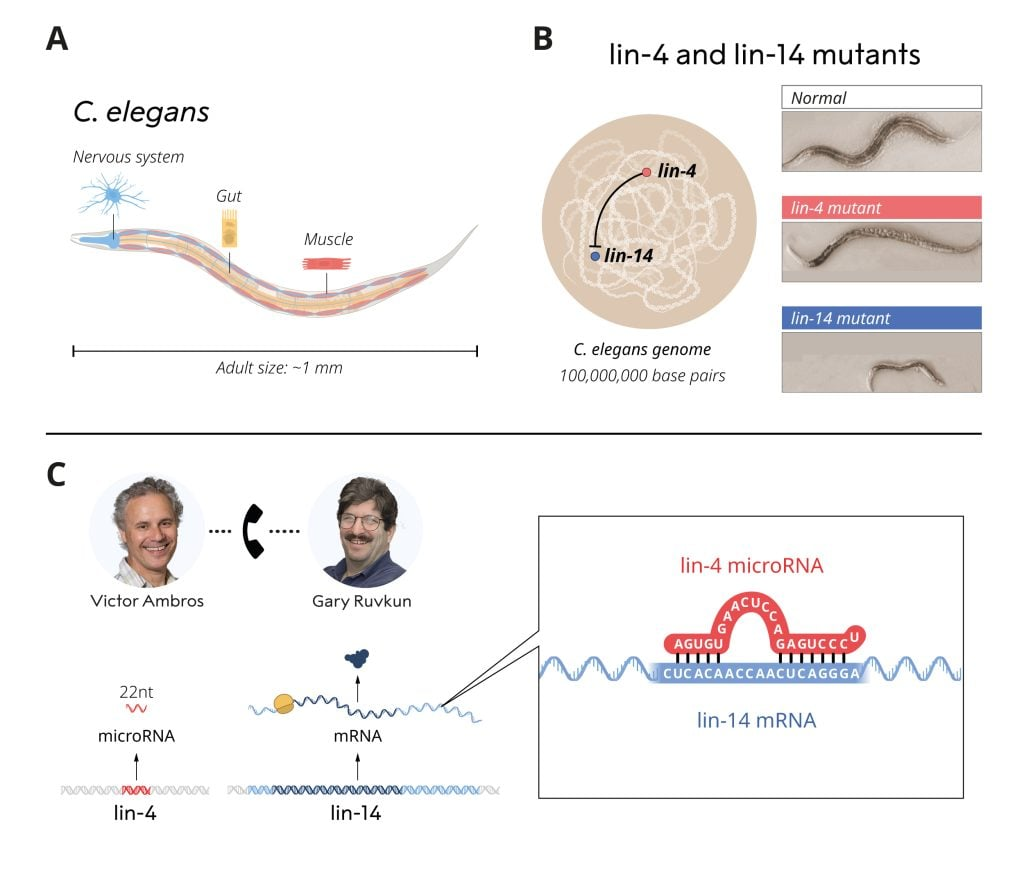MicroRNA discovery marks a pivotal moment in molecular biology, fundamentally changing our understanding of gene regulation. Originally unveiled through the groundbreaking work of Nobel laureate Gary Ruvkun in the C. elegans roundworm, this tiny RNA molecule has significant implications for how genes are expressed and regulated. Ruvkun, along with his collaborator Victor Ambros, published their findings in 1993, shedding light on a new layer of genetic control that would eventually earn them the Nobel Prize in 2024. This exciting advancement in RNA research not only highlights the intricacies of genetic expression but also opens doors for innovative therapies aimed at diseases such as cancer and Alzheimer’s. As we delve deeper into the implications of microRNA, it becomes clear that understanding its role is crucial for the future of biomedical science.
The exploration of small RNA molecules has ushered in a new era in genetic understanding, especially evident in the field of gene regulation. The concept of microRNA, which involves minor yet powerful regulators of gene expression, has garnered significant attention since its initial identification. Esteemed researchers like Gary Ruvkun have led the charge in this fascinating domain, paving the way for profound advancements in biomedical therapy and research. This burgeoning field holds immense promise for treating various diseases, illustrating the interplay between genetics and health. As we further investigate these minute yet influential RNA molecules, we uncover vital pathways that could transform our approach to medicine and therapeutic interventions.
The Pioneering Work of Gary Ruvkun in microRNA Discovery
Gary Ruvkun’s groundbreaking discovery of microRNA in 1992 marked a significant advancement in our understanding of gene regulation. His research, conducted alongside Victor Ambros, initially faced skepticism from the evolutionary biology community. Despite publishing their findings in the prestigious journal Cell, the implications of microRNA in organisms beyond the C. elegans roundworm were not immediately recognized. This early work laid a foundation for extensive RNA research, leading to new insights into how non-coding RNA molecules regulate gene expression in numerous species, including humans.
As Ruvkun reflects on his journey, he highlights a growing appreciation for the roles microRNAs play in various biological processes. These small RNA fragments are now understood to be crucial in the regulation of developmental timing and tissue-specific gene expression. Over two decades later, Ruvkun and Ambros would be awarded the 2024 Nobel Prize in Physiology or Medicine for their contributions to this field, affirming the importance of their work as foundational to modern genetics and molecular biology.
Gene Regulation and the Impact of microRNAs in Human Health
The discovery of microRNAs has revolutionized our understanding of gene regulation, particularly in its implications for human health. Research indicates that approximately 1,000 microRNAs are present in the human genome, and these tiny molecules play a pivotal role in controlling the expression of most genes responsible for protein production. This regulation has profound implications, as dysregulation of microRNAs has been linked to various diseases, including cancer, heart disease, and neurodegenerative disorders.
Current medical research is increasingly focused on developing therapies that harness the power of microRNAs. Clinical trials are underway to assess treatments for conditions such as Crohn’s Disease and Alzheimer’s, showcasing the translational potential of basic research conducted by scientists like Ruvkun. By understanding the mechanisms of microRNA activity, researchers aim to create targeted interventions that could revolutionize current treatment methodologies in modern medicine.
The Role of NIH Funding in Advancing RNA Research
Federal funding, especially from the National Institutes of Health (NIH), has been essential in advancing research on microRNAs and RNA biology. Gary Ruvkun has noted that a significant portion of his lab’s funding has come from federal grants, which have supported over four decades of groundbreaking research. This financial backing has allowed scientists to explore uncharted territories in gene regulation and has been critical in fostering new discoveries that have transformed our understanding of biology and healthcare.
Ruvkun’s advocacy for sustained federal support underlines its importance in maintaining a robust scientific community. The relationship between federal grants and transformative discoveries highlights how sustained investment can generate substantial returns in public health and technology sectors. As companies leveraging RNA-based technologies, such as Alnylam Pharmaceuticals, emerge and thrive, the impact of NIH funding becomes even more evident, illustrating how strategic investments in science can lead to significant economic and medical advancements.
The Evolution of the RNA Research Community
Since the initial discovery of microRNAs, the RNA research community has transformed dramatically. What began as a niche area of interest has grown into a robust field, attracting attention from researchers across a multitude of disciplines. Conferences that previously garnered small audiences now regularly draw crowds of hundreds, reflecting the skyrocketing interest in RNA biology and gene regulation. This shift underscores the collaborative nature of modern science and the increasing recognition of the relevance of microRNAs across the biological spectrum.
As interest in RNA research has surged, so has the complexity and interconnectivity of studies exploring gene regulation mechanisms. Collaborative efforts among researchers from diverse fields have led to novel insights that transcend traditional disciplinary boundaries. This evolution illustrates the power of microRNA research not only in understanding basic biology but also in applying this knowledge to clinical challenges, ultimately benefiting public health outcomes.
C. elegans as a Model Organism in RNA Studies
C. elegans, a microscopic roundworm, has long served as an invaluable model organism in biological research, particularly in the field of RNA studies. The simplicity of its genome and the organism’s well-mapped development enable researchers to study gene regulation in a controlled environment. Gary Ruvkun and Victor Ambros utilized C. elegans to uncover the initial roles of microRNAs, setting a precedent for how model organisms can illuminate fundamental biological processes that are conserved across species.
The insights gleaned from studying C. elegans have not only propelled the understanding of microRNAs but have also paved the way for advances in the field of genetics. As researchers explore the functionalities and interactions of microRNAs across various organisms, including humans, C. elegans remains a cornerstone for experiments aimed at deciphering the complexities of gene regulation and RNA biology.
The Future of MicroRNA Research and Its Implications
As the field of microRNA research continues to expand, scientists are increasingly focused on the therapeutic potential of these molecules. With ongoing clinical trials investigating microRNA-based therapies for diseases such as cancer and neurodegenerative disorders, the future looks promising. Innovative techniques in genetic engineering and RNA technology are being developed to harness the gene-regulatory capabilities of microRNAs, proposing new avenues for treatment strategies that could significantly alter patient outcomes.
However, the rapid growth of this field also raises questions about the ethical implications of manipulating gene regulation through RNA therapies. As researchers navigate these complexities, the foundational work of scientists like Gary Ruvkun reminds us of the importance of grounding new technologies in rigorous scientific inquiry. The collaboration between basic and applied research will be essential in realizing the full therapeutic potential of microRNAs while ensuring that ethical standards are upheld in the quest for medical advancements.
The Significance of Interdisciplinary Collaboration in RNA Research
Interdisciplinary collaboration has emerged as a crucial element in the advancement of RNA research, underscoring the necessity of diverse perspectives in scientific inquiry. The integration of knowledge from genetics, molecular biology, bioinformatics, and clinical medicine has sparked innovative approaches to studying microRNAs and their roles in gene regulation. Gary Ruvkun’s experience exemplifies how collaborative efforts among researchers can pool expertise and resources to address complex biological questions.
As more scientists from varied fields contribute to RNA research, the potential for groundbreaking discoveries increases exponentially. By fostering a culture of collaboration, researchers can share insights, methodologies, and technologies that pave the way for novel applications of microRNA research. This interdisciplinary approach not only enhances the understanding of gene regulation but also collectively advances the fight against diseases, emphasizing the importance of unity in scientific progress.
From Basic Research to Commercialization: The Path of RNA Technologies
One of the most remarkable achievements stemming from Gary Ruvkun’s foundational research on microRNAs is the successful transition from basic scientific discovery to the commercialization of RNA-based therapies. Companies like Alnylam Pharmaceuticals, which have emerged from academic research, are pioneering RNA interference therapeutics that target genetic diseases with precision. This evolution embodies the impact of basic research on practical applications in medicine, demonstrating the cyclical nature of scientific advancement.
The pathway from discovery to commercialization is complex, often requiring substantial investment and collaboration between academic institutions and the biotechnology industry. As researchers continue to uncover the intricacies of RNA biology, the potential for translating these findings into viable therapeutic options grows. This highlights not only the importance of federal funding in sustaining research efforts but also the dynamic relationship between academia and industry in driving innovation forward.
The Role of Education and Training in Advancing RNA Research
The continuing advancement of RNA research is heavily reliant on the education and training of new scientists entering the field. Gary Ruvkun emphasizes that building a skilled workforce equipped with knowledge of RNA biology is essential for sustaining innovation in gene regulation studies. As the landscape of scientific research evolves, educational institutions must adapt their curricula to incorporate RNA-related topics, preparing future generations to tackle the challenges presented by this rapidly-growing field.
Furthermore, providing opportunities for hands-on experience in laboratories is critical for fostering the next generation of RNA researchers. By engaging students in projects that explore the roles of microRNAs and other gene regulatory elements, we cultivate a workforce that is not only knowledgeable but also passionate about contributing to the field. Investing in education and training ensures that the legacy of groundbreaking discoveries will continue, maintaining the momentum of scientific progress in RNA research.
Frequently Asked Questions
What is microRNA discovery and its significance in gene regulation?
MicroRNA discovery refers to the identification of small non-coding RNAs that play a crucial role in gene regulation. This innovative research first highlighted by Gary Ruvkun in C. elegans revealed a new dimension of how genes are controlled, influencing processes such as development and disease progression. MicroRNAs are vital for translating genes into proteins, making them fundamental to cellular function.
How did Gary Ruvkun contribute to microRNA discovery?
Gary Ruvkun, along with Victor Ambros, was instrumental in the discovery of microRNAs in 1992 while studying C. elegans. Their findings, published in 1993, unveiled the importance of these tiny RNAs in gene regulation, laying the groundwork for understanding their roles in various biological processes and earning them the 2024 Nobel Prize in Physiology or Medicine.
Why is the study of microRNA important for RNA research?
The study of microRNA is crucial for RNA research because it has unveiled new mechanisms of gene expression regulation. MicroRNAs impact crucial biological functions, as demonstrated in Ruvkun’s work. Their roles in diseases such as cancer and heart disease have sparked interest in developing targeted therapies, underlining their significance in both basic and clinical research.
What are some applications of microRNA research in medical therapies?
MicroRNA research has pivotal applications in developing therapies for various diseases, including heart disease, cancer, Crohn’s Disease, and Alzheimer’s. Clinical trials assessing these therapies are underway, reflecting their potential to alter treatment paradigms by targeting the underlying mechanisms of diseases discovered in Ruvkun’s foundational work.
What impact has microRNA discovery had on our understanding of human genetics?
MicroRNA discovery has significantly shaped our understanding of human genetics by revealing that there are approximately 1,000 microRNAs within the human genome that regulate the majority of protein-coding genes. This relationship is essential for understanding genetic expression and its implications for health and disease.
How has federal funding contributed to advancements in microRNA research?
Federal funding has been a cornerstone in advancing microRNA research, providing financial support that facilitated groundbreaking discoveries, like those made by Ruvkun. Sustained governmental investment has enabled numerous studies, allowing for exploration into the therapeutic potential of microRNAs across various medical conditions.
What is the future direction of microRNA research after the Nobel Prize recognition?
Following the recognition of Ruvkun and Ambros with the 2024 Nobel Prize, microRNA research is poised for expansive growth. Increased interest from both scientific communities and pharmaceutical industries may lead to innovative therapies and a deeper understanding of gene regulation, reflecting the revolutionary impact of their work on modern biology.
| Key Point | Details |
|---|---|
| Discovery of microRNA | Gary Ruvkun and Victor Ambros discovered microRNA in 1992, which would later earn them the 2024 Nobel Prize. |
| Initial Reception | Their discovery was initially overlooked by the evolutionary biology community, who were skeptical of its relevance to other species. |
| Funding and Support | Much of their research funding came from the National Institutes of Health, crucial for developing their work. |
| Impact on Medicine | MicroRNAs are involved in therapies for heart disease, cancer, Crohn’s Disease, and Alzheimer’s, currently in clinical trials. |
| Role in Human Genome | The human genome contains about 1,000 microRNAs that regulate most protein-producing genes. |
| Growth of RNA Research | As knowledge expanded, interest in microRNAs surged, doubling attendance at related scientific meetings within a few years. |
| Economic Contributions | Research has facilitated the rise of biotech companies like Alnylam, which specializes in RNA therapeutics. |
| Future of Research | Ruvkun highlights concerns over federal funding cuts which could deter new talent from pursuing scientific careers. |
Summary
MicroRNA discovery has transformed our understanding of gene regulation, highlighting its crucial role in developmental biology and medicine. Pioneered by Gary Ruvkun and Victor Ambros, the identification of microRNAs has not only earned them a Nobel Prize but also paved the way for innovative therapies addressing major diseases. As new research continues to unfold, the implications of microRNA remain significant, underpinning advancements in various health-related fields and emphasizing the need for sustained funding to nurture future scientific exploration.



